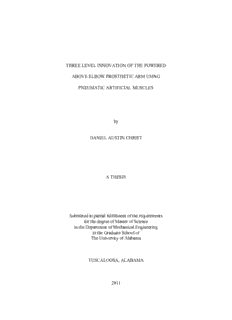
THREE LEVEL INNOVATION OF THE POWERED ABOVE ELBOW PROSTHETIC ARM USING ... PDF
Preview THREE LEVEL INNOVATION OF THE POWERED ABOVE ELBOW PROSTHETIC ARM USING ...
THREE LEVEL INNOVATION OF THE POWERED ABOVE ELBOW PROSTHETIC ARM USING PNEUMATIC ARTIFICIAL MUSCLES by DANIEL AUSTIN CHRIST A THESIS Submitted in partial fulfillment of the requirements for the degree of Master of Science in the Department of Mechanical Engineering in the Graduate School of The University of Alabama TUSCALOOSA, ALABAMA 2011 Copyright Daniel Austin Christ 2011 ALL RIGHTS RESERVED ABSTRACT This thesis presents a novel above elbow prosthetic arm design, innovating on three different levels: the actuation method, system integration, and the mechanism design. The Chemo-Muscle actuation system expands pneumatic artificial muscles to mobile applications. The integrated design makes use of the internal dead space of the muscle, incorporating external components and reducing fuel consumption. A novel design is presented using smaller muscles to control multiple degrees of freedom, providing 50% more strength than other prosthetic arms and an excellent range of motion for each degree of freedom. A simple control method is proven and the future development is discussed. ii DEDICATION To my wife, Amy Thank you for your generous kindness, love and support. Now and always. iii LIST OF ACRONYMS AND ABBREVIATIONS AE Above Elbow APL John Hopkins Applied Physics Laboratory CAD Computer Aided Design CNC Computer Numerically Controlled Machining DARPA Defense Advanced Research Project Agency DOF Degree(s) of freedom EMG Electromyographic Signal OIF/OEF Operation Iraqi Freedom/Operation Enduring Freedom PAM Pneumatic Artificial Muscle RIC Research Institute of Chicago TMR Targeted Muscle Reinnervation iv ACKNOWLEDGMENTS I would like to thank the National Science Foundation GK-12 program for their financial support as well as for the opportunity to be part of such a unique educational fellowship experience. I would like to thank Dr. Xiangrong Shen for providing me with the opportunity to work on this project and for his assistance and encouragement along the way. I would like to thank Dr. Beth Todd for introducing me to many great programs The University of Alabama offers and helping me to get involved and give back. I would also like to thank Dr. Rajnish Sharma for his assistance and enthusiasm as a member of my thesis committee. Finally, I would like to thank my fellow students, Garrett Waycaster, Marco Wu, Alston Pike and Miguel Sequera for their support, encouragement and camaraderie. v CONTENTS ABSTRACT .............................................................................................................................. ii DEDICATION .......................................................................................................................... iii LIST OF ACRONYMS AND ABBREVIATIONS ................................................................... iv ACKNOWLEDGMENTS ...........................................................................................................v LIST OF TABLES .................................................................................................................... xi LIST OF FIGURES ................................................................................................................. xii CHAPTER 1: INTRODUCTION ...............................................................................................1 1.1 MOTIVATION & OBJECTIVE ........................................................................................2 1.1.1 MOTIVATION ...........................................................................................................2 1.1.2 OBJECTIVE ...............................................................................................................4 1.2 PROSTHETICS: BACKGROUND AND LITERATURE REVIEW ..................................5 1.2.1 TRADITIONAL UPPER LIMB PROSTHETICS ........................................................5 1.2.2 EARLY ELECTRONIC PROSTHETICS ....................................................................9 1.2.3 REVOLUTIONIZING PROSTHETICS .................................................................... 12 1.2.4 OTHER RELATED RESEARCH ............................................................................. 17 1.3 PNEUMATIC ARTIFICIAL MUSCLES ......................................................................... 21 1.3.1 BIOLOGICAL MUSCLES........................................................................................ 21 vi 1.3.2 PNEUMATIC ARTIFICIAL MUSCLE CHARACTERISTICS ................................ 24 1.3.3 APPLICATIONS OF PAMS ..................................................................................... 25 1.3.4 DRAWBACKS OF THE PAM.................................................................................. 25 REFERENCES ...................................................................................................................... 26 CHAPTER 2: THE CHEMO-MUSCLE ACTUATION SYSTEM ........................................... 29 2.1 CHAPTER ABSTRACT .................................................................................................. 30 2.2 INTRODUCTION ........................................................................................................... 30 2.3 SYSTEM DESIGN .......................................................................................................... 31 2.4 MODELING THE CHEMO-MUSCLE ACTUATION SYSTEM .................................... 34 2.4.1 LOAD DYNAMICS .................................................................................................. 35 2.4.2 PRESSURE-FORCE RELATIONS ........................................................................... 35 2.4.3 PRESSURE DYNAMICS ......................................................................................... 36 2.4.4 VALVE FLOW DYNAMICS ................................................................................... 38 2.5 CONTROLLER DESIGN ................................................................................................ 41 2.6 EXPERIMENTAL RESULTS ......................................................................................... 43 2.7 CONCLUSIONS ............................................................................................................. 48 REFERENCES ...................................................................................................................... 49 CHAPTER 3: REDUCING EFFECTIVE VOLUME OF PNEUMATIC ARTIFICIAL MUSCLE WITH COMPONENT INTEGRATION ................................................................... 50 3.1 ABSTRACT .................................................................................................................... 51 3.2 INTRODUCTION ........................................................................................................... 52 vii 3.3 ENERGY-SAVING MECHANISM ................................................................................ 54 3.4 A PRACTICAL DESIGN WITH VALVE INTEGRATION ............................................ 57 3.5 SIMULATED EXPERIMENTS ...................................................................................... 61 3.6 CONCLUSIONS ............................................................................................................. 67 REFERENCES ...................................................................................................................... 68 CHAPTER 4: PROSTHETIC PROTOTYPE DESIGN............................................................. 70 4.1 INTRODUCTION ........................................................................................................... 71 4.2 ARM STRUCTURE ........................................................................................................ 71 4.2.1 BIOLOGICAL ARM STRUCTURE ......................................................................... 71 4.2.2 STRUCTURE OF PROSTHETIC PROTOTYPE ...................................................... 73 4.2.3 MOTIONS AND ACTUATIONS OF THE PROSTHETIC PROTOTYPE ................ 77 4.3 DESIGN DETAILS ......................................................................................................... 81 4.3.1 RADIULNA .............................................................................................................. 81 4.3.2 PRONATION COUPLING ....................................................................................... 83 4.3.3 PRONATION PIN .................................................................................................... 84 4.3.4 ELBOW BRACKET ................................................................................................. 85 4.3.5 ELBOW PULLEY ASSEMBLY ............................................................................... 86 4.3.5.A VARIABLE RADIUS PULLEYS ...................................................................... 88 4.3.5.B ANCHOR BLOCK ............................................................................................. 93 4.4.5.C ELECTROLINE CABLE END FITTINGS ......................................................... 93 viii 4.4 PROTOTYPE MANUFACTURING AND ASSEMBLY ................................................ 94 4.4.1 PROTOTYPE MANUFACTURING ......................................................................... 94 4.4.2 PROTOTYPE ASSEMBLY ...................................................................................... 99 4.4.3 ADJUSTMENTS MADE DURING ASSEMBLY ................................................... 105 4.5 CONCLUSION ............................................................................................................. 107 REFERENCES .................................................................................................................... 107 CHAPTER 5: PROTOTYPE TESTING AND CONTROL .................................................... 108 5.1 ABSTRACT .................................................................................................................. 109 5.2 EXPERIMENTAL SETUP ............................................................................................ 109 5.3 DESIGN MODIFICATIONS DURING TESTING ........................................................ 110 5.3.1 SIMPLE MODIFICATIONS ................................................................................... 111 5.3.2 COMPLEX MODIFICATIONS .............................................................................. 112 5.4 SIMPLE CONTROL ..................................................................................................... 117 5.5 DISCUSION OF RESULTS .......................................................................................... 118 CHAPTER 6: FUTURE WORK AND CONCLUSIONS ....................................................... 122 6.1 FUTURE WORK .......................................................................................................... 123 6.1.1 CONFORMAL MULTI-UNIT ACTUATION ......................................................... 123 6.1.2 INTEGRATED CHEMO-MUSCLE PROSTHETIC ARM ...................................... 125 6.2 CONCLUSION ............................................................................................................. 126 REFERENCES .................................................................................................................... 126 ix
Description: